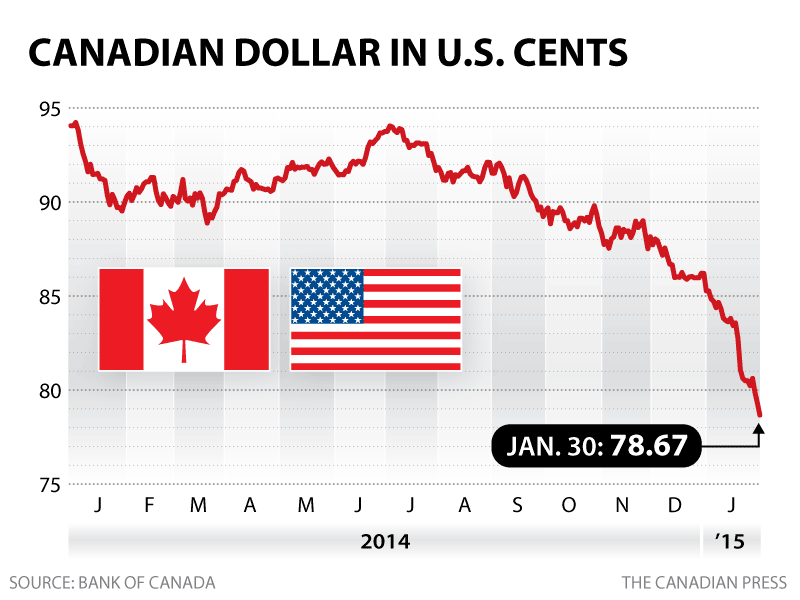 On January 23, the Bank of Canada posted its inflation figures for December. Among the figures, the standout reading was the 3.7% increase in food costs from December 2013.
On January 23, the Bank of Canada posted its inflation figures for December. Among the figures, the standout reading was the 3.7% increase in food costs from December 2013.
At the end of 2013, The Food Institute of Ontario’s University of Guelph predicted that food prices would increase 0.3-2.6% in 2014, considerably below the final figure. Meat and fish rose through the year by 12.4% and 5.9% respectively, while in 2015 the institute expects them to rise, along with vegetables, by an additional 3-5%.
Several factors have contributed to the ongoing price surge. The US has experienced several years of drought, which adversely impacted supply costs for farmers and ultimately translated into higher prices on food exported to Canada, particularly vegetables.
The Canadian dollar (CAD) has also weakened significantly, falling last month to its lowest level -below 79 cents – against the US dollar (USD) since early 2009:

Source: Canadian Press | Bank of Canada
The price of oil, Canada’s main export, has continued to plummet since July of 2012, severely affecting the country’s currency. This has, in turn, led to USD-denominated imports of food becoming significantly more expensive. Recently the CAD dropped further against the USD after markets were caught by an unexpected cut in rates by the Bank of Canada. This will further inflate imported food prices.
The price of meat was overwhelmingly affected by the ‘supply shortage’ of Canadian pigs due to the outbreak of porcine epidemic diarrhoea (PED), which resulted in 25% price hikes for pork products such as bacon. Higher grain costs for cattle feed impacted beef prices, while prices for livestock and hogs recently hit their highest price in two decades.
Thankfully for meat consumers, the Food Institute’s study predicts that PED impact on prices will be relatively short-lived – prices are still expected to increase this year but at a substantially lower rate. For meat retailers, however, prices have stayed high for too long. The January 7 edition of The Province newspaper contains interviews with several Vancouver meat sellers who have all expressed dismay at the rising meat prices. They expect the increased costs, at one time mostly absorbed by the retailers, to gradually be passed on to consumers as profit margins are being eroded on a weekly basis.
The food price inflation is having an adverse impact on household savings. According to the St. Albert Gazette, some consumers are now considering buying domestic produce, rather than relying on US imports which are exposed to exchange rate fluctuations. Others, meanwhile, believe that low prices are still to be found if consumers ‘shop around’ more.
Nonetheless, a shift toward stores that sell in bulk quantities at heavily discounted prices is expected should the current level of food price inflation remain. If such a shift occurs, grocery stores are expected to lower their prices in an effort to remain as competitive as possible.
Some supermarkets have benefitted from the higher food prices, however. Chain store Metro Inc. reported fourth-quarter profit on November 19, 2014, that was 45% higher than 2013’s final quarter. The 2.5% increase in food prices during the year was cited as one of the principal contributing factors to the supermarket’s performance. Metro’s stock price skyrocketed on the same day by 2.62% to $84.66 – which was an all-time high – and has continued to gain, reaching a new record of $106.52 on February 5th 2015.
More recently Metro announced very positive first quarter results, ended December 20. Net income rose by 13.4% from the previous year, while adjusted earnings per share stood at $1.35, marking an annual increase of 21.6%. Sales were also up by 5.2% to $2.84 billion. Although much of this growth can be attributed to its acquisition of bakery and retailer Première Moisson, Metro’s earnings report also highlighted another decisive factor, namely the conversion of some of its Ontario stores into Food Basics – Metro’s chain of discount supermarkets. This has attracted a growing number of customers who have become weary of inflated food prices and provides further evidence of the increasing trend in customers’ food purchasing habits towards outlets with discounted food prices.

